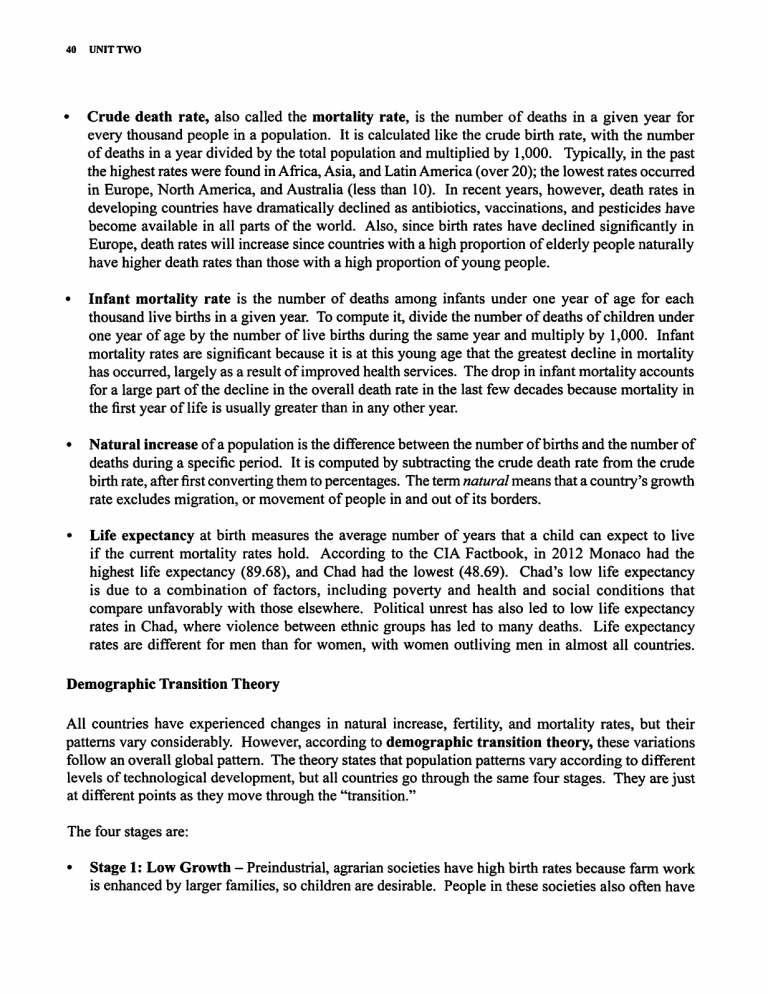
40 UNITTWO • Crude death rate, also called the mortality rate, is the number of deaths in a given year for every thousand people in a population. It is calculated like the crude birth rate, with the number of deaths in a year divided by the total population and multiplied by 1,000. Typically, in the past the highest rates were found in Africa, Asia, and Latin America (over 20); the lowest rates occurred in Europe, North America, and Australia (less than 10). In recent years, however, death rates in developing countries have dramatically declined as antibiotics, vaccinations, and pesticides have become available in all parts of the world. Also, since birth rates have declined significantly in Europe, death rates will increase since countries with a high proportion of elderly people naturally have higher death rates than those with a high proportion of young people. • Infant mortality rate is the number of deaths among infants under one year of age for each thousand live births in a given year. To compute it, divide the number of deaths of children under one year of age by the number of live births during the same year and multiply by 1,000. Infant mortality rates are significant because it is at this young age that the greatest decline in mortality has occurred, largely as a result of improved health services. The drop in infant mortality accounts for a large part of the decline in the overall death rate in the last few decades because mortality in the first year of life is usually greater than in any other year. • Natural increase of a population is the difference between the number of births and the number of deaths during a specific period. It is computed by subtracting the crude death rate from the crude birth rate, after first converting them to percentages. The term natural means that a country's growth rate excludes migration, or movement of people in and out of its borders. • Life expectancy at birth measures the average number of years that a child can expect to live if the current mortality rates hold. According to the CIA Factbook, in 2012 Monaco had the highest life expectancy (89.68), and Chad had the lowest (48.69). Chad's low life expectancy is due to a combination of factors, including poverty and health and social conditions that compare unfavorably with those elsewhere. Political unrest has also led to low life expectancy rates in Chad, where violence between ethnic groups has led to many deaths. Life expectancy rates are different for men than for women, with women outliving men in almost all countries. Demographic Transition Theory All countries have experienced changes in natural increase, fertility, and mortality rates, but their patterns vary considerably. However, according to demographic transition theory, these variations follow an overall global pattern. The theory states that population patterns vary according to different levels of technological development, but all countries go through the same four stages. They are just at different points as they move through the "transition." The four stages are: • Stage 1: Low Growth - Preindustrial, agrarian societies have high birth rates because farm work is enhanced by larger families, so children are desirable. People in these societies also often have POPULATION 41 little access to birth control. Death rates are high because of low standards of living and little medical technology. As a result, natural increase was close to zero, and world population did not grow. Stage 1 characterized the earth's population until the mid-18th century, and some societies today are still in this initial phase. • Stage 2: High Growth- Around 1750 industrialization brought about a demographic transition in Europe as death rates fell because of greater food supplies and scientific medicine. Yet birth rates remained high, so the natural increase exploded. The drop in the death rate became significant by the mid-19th century, and is known as the "mortality revolution," or epidemiological transition. Another explanation for the drop in death rates is that fatal epidemic diseases became endemic, with the population developing partial immunities, so that deaths declined. New machines helped farmers increase agricultural production and feed the rapidly growing population, causing life expectancy to increase. According to demographic transition theory, many of the world's poorest countries today are in this high-growth stage with falling death rates but stable, high birth rates. • Stage 3: Moderate Growth- This is the stage of a mature industrial economy, when the birth rate drops, curbing population growth once again. In Europe a rapid urbanization occurred as industrialization created more jobs in cities. According to demographic transition theory, fertility rates fall because more children survive to adulthood with improved health standards and access, and because high standards of living make raising children expensive. Children become economic liabilities rather than assets (as in Stages 1 and 2) because they require more years of schooling, and the nature of work changes so that child labor is restricted. Smaller families are made possible by birth control, and as birth rates follow death rates downward, the population growth slows further. • Stage 4: Low Growth - In this stage a post-industrial economy completes the demographic transition. The birth rate keeps falling, partly because more women are working outside the home and partly because children become even more expensive. Higher education levels encourage women to delay marriage and children, and children need extensive education to fill post-industrial jobs. These trends are accompanied by steady death rates, so that population grows only very slowly or even decreases. This cycle of growth stages has occurred in the United Kingdom and much of Europe, where countries have a population growth rate of close to zero. However, critics of demographic transition theory warn that it may be unwise to assume that all countries' demographic cycles will follow the sequence that occurred in industrializing Europe. The theory rests on the prediction that all countries will eventually industrialize, which is not necessarily true. Even if and when they do industrialize, population bases are much larger than they were when the population revolution began in Europe, so the effects may be different. For example, China is quickly industrializing now, but the population stands at about 1.4 billion, despite the fact that the one-child policy has been in effect for several decades. However, many demographers are predicting that most countries will stop growing at some time during the 21st century, and will reach stationary population level (SLP). However, these predictions are under constant revision, and no one knows for sure if and when the population explosion will end. 42 UNITTWO 40 ~--------~--------~--------~------~ 0 0 0 oe- 30 ~--------~--~~--~--------~~--------, 20 ~--------~----~L-~~--~~--~--------_, ... ~ ! ~ 10 Stage 1 0 Stage 2 Stage 3 Stage 4 ~----------------------------~----------Year_.s____..~~ Stages in the Demographic Transition. According to demographic transition theory, all societies follow the same four demographic stages, causing population growth rates to vary considerably. POPULATION AND NATURAL HAZARDS Population levels have always fluctuated according to the natural environment. Historically when climate conditions have been favorable, population increases, partly because the food supply is sufficient when the climate is good. People adapt their life styles to climate conditions, so that predictable weather patterns are easily managed. However, should dramatic changes occur, the death rate would likely increase until adaptations, such as warmer housing and better methods of heating spaces, are made. For example, populations in many parts of Eurasia appear to have decreased significantly during the "Little Ice Age" of the 17th century. Likewise, population levels mat be negatively impacted by natural disasters, such as drought, hurricanes, typhoons, and tsunamis. Two of Malthus's "negative checks" - famine and disease - have often been the result of natural hazards that impact food production. In modem times in many areas, human endeavors have often lessened these negative checks through better health care and more control over food production. Many diseases have been either eradicated or controlled, and even though food distribution is still a problem that leads to famine, people in many countries now have access to nutritious foods. However, globalization has meant more contacts among peoples of the earth, and one result is the potential for rapid spread of communicable diseases. One example is AIDS (Acquired Immune Deficiency Syndrome), a disease that began in central Africa during the late 20th century, and spread to many countries around the world before the end of the century. Scientists warn of future outbreaks of Asian bird flu, a deadly virus that has been known to spread from birds to humans, and has the potential to become a major outbreak if not contained to localities. The fear of a pandemic (widespread epidemic) caused many areas in China and Southeast Asia to be strictly quarantined in 2003, with much international travel curtailed and many everyday activities highly restricted in the quarantined areas. Another threat - the swine flu - began in Mexico in 2009 and spread to other countries as international agencies kept a close eye on its progress. POPULATION 43 EFFECTS OF POPULATION POLICIES Over the past century many national governments have designed policies to influence the overall growth rate of their populations. Most governments today seek to reduce the rate of natural increase through various forms of restrictive population policies. These policies range from toleration of officially banned means of birth control to the actual prohibition of large families. Since the 1990s the United Nations and other international organizations have also taken an interest in controlling population growth. China and India: National Population Policies The two most populous countries of the world- China and India- have taken very different approaches to population growth. Their contrasting policies have resulted in different current population patterns and problems, as well as predictions for the future. China In 1965 Chinese leader Mao Zedong announced that an ever-expanding population is a "good thing," and in 1974 he denounced population policies as "imperialist tools" designed to weaken developing countries. At the time of Mao's death in 1976, China had about 850 million people with a birth rate of25. His successors recognized that population growth was consuming more than half of the annual increase in the country's gross domestic product, so China introduced a campaign advocating the "twochild family." The government provided services- including abortions- that supported the program, resulting in a drop in China's birth rate to 19.5 by the late 1970s. In 1979, China's new leader, Deng Xiaoping, went even further by instituting the "one child policy." This program included both incentives and penalties to assure that couples produced only one child. Late marriages were encouraged, and free contraceptives, abortions, and sterilizations were provided to families that followed the policy. Penalties, including steep fines, were imposed on couples that had a second child. In 1984 the policy was relaxed in rural areas, where children's labor was still important, but it was reinstated in 2002 in reaction to reports that many rural births were not being reported to the government. In contrast, Chinese people in cities were generally more accepting of the one-child policy since it better suited urban life styles and needs. By 1986 the birth rate had fallen to 18, a figure far below those in other less developed countries. However, the policy has had other consequences. One was a rise in female infanticide, or the killing of baby girls. Because traditional Chinese society has always valued males above females, many couples have wanted their one child to be a boy. If a girl is born instead, some choose to end the child's life so that they can try again to have a boy. The incidence of female infanticide is almost impossible to tally, but the practice has led to a disproportionate number of male to female children. In more recent years, as technology has allowed parents to know the gender of the child before birth, female infanticide has been replaced- at least in urban areas- with selective abortions. Over the years China's population pyramid has developed a lopsided number of young adult males to young adult females. The problem is so serious that many young men are unable to find women to marry. Some projections suggest that by the mid-21st century China's population numbers will start falling. If that occurs, it almost certainly will change the cultural tradition of sons taking care of their aging parents. There could be too few sons to carry out the responsibility, leaving China with a problem of what to do about a growing number of elderly people with no one to take care of them. 44 UNITTWO Census figures from 2010 indicate that demographics in China have changed rapidly in recent years. Not only is the ratio ofbaby boys to baby girls out of proportion, but China's population is dramatically aging. People above the age of60 now represent 13.3% of the total, up from 10.3% in 2000, and those under the age of 14 declined from 23% to 17%. An increasingly vocal group of academic demographers has called for a relaxation of the one-child policy, and in 2011, one Chinese official in Guangdong China's most populous province- joined in the criticism by advocating a "two-child" policy. Already, many exceptions exist, such as the allowance of two children for couples in which both partners are single children. Minorities - such as Tibetans and Uyghurs - are permitted a second child, whatever the sex of the first born, and the regulations are most relaxed in rural areas, where population pressures are minimal. India Unlike China, India has had a problem coordinating a centralized population policy. India is a federation of 28 states and 7 "union territories," all of which are culturally and politically diverse. The national government cannot force its will on the states and territories with their various problems and policies. Population growth is the greatest in the northeast in Assam, Nagaland, and Mizoram, where the rate of natural increase exceeded 4.5% during the 1970s. As a result, famine has plagued the area, even when there is adequate food in other parts of the country. The Indian government started population planning in the 1950s by providing limited funds for familyplanning clinics and programs, but they did little to stop population growth. In the 1960s the government invested heavily in a national program that it encouraged the states to join. However, rapid population growth continued, especially in the eastern states. Some of the state programs were controversial and unpopular. For example, in Maharashtra (the southwest) rioting broke out in opposition to a plan Population Pressures in India. Population growth characterizes the entire country, but population pressures are greater in Assam, Nagaland, and Mizoram. POPULATION 45 that required sterilization of anyone with three children or more. Today Indian state governments use advertising and persuasion to encourage families to have fewer children. A network of clinics has been established to aid women even in small villages. Despite these coordination problems, India's birth rate has dropped by more than half in 35 years- from 5.7 children per woman in the mid-1960s to 2.7 in 2010. Nearly a third of India's people have lowered their fertility to replacement levels. However, most demographers predict that India will overtake China as the world's most populous country as early as 2030. So far, India's governments have been unable to come up with the coordination of resources necessary to curtail the continuing population growth. International Policy Efforts During the 1990s international organizations, especially the United Nation, began to coordinate efforts to control population growth on a global level. For the first time, population policy was officially tied to women's empowerment, especially in terms of their control over the number of children that they have. According to a statement issued by the International Conference on Population and Development, held in Cairo in 1994: "Improving the status of women also enhances their decision-making capacity at all levels in all spheres of life, especially in the area of sexuality and reproduction. This, in turn, is essential for the long-term success of population programmes. Experience shows that population and development programmes are most effective when steps have simultaneously been taken to improve the status of women."* *Reference: "United Nations Population lnfonnation Network," www.un.org/popin/icpd/conferencc/offenglpoa.html The Conference recommended that national governments pass laws that allow women to combine family roles with participation in the workforce. In 1995 the United National Fourth World Conference on Women was held in Beijing and attended by women from many countries, including less developed ones. The Conference affirmed the importance of women's ability to control their own fertility, especially in terms of allowing them to take advantage of educational and employment opportunities. POPULATION MOVEMENT People move from one place to another constantly, usually within a relatively small land space. For example, people move from home to work, shopping centers, school, or recreational and religious centers. This type of short-term, repetitive movement that occurs on a regular basis is called circulation. Migration is a different type of mobility because it involves a permanent move to a new location, either within a single country or from one country to another. Spatial interaction is the broad geographical term for the movement of peoples, ideas, and commodities within and between areas, whether it is circulation or migration. Geographers are generally more interested in migration than circulation because migration produces important changes for individuals and the regions that they move to and from. When relocations occur across political boundaries, they affect the population structures of both the areas of origin and destination. The demographic equation summarizes the population change over time in an area by combining natural change (death rate subtracted from birth rate) and net migration. Emigration is migration from a location, and immigration is migration to a location. Both types of migration usually occur at once; the difference is the net-migration rate for a region or country. 46 UNITTWO RAVENSTEIN'S LAWS OF MIGRATION In 1885 British demographer Ernst Ravenstein wrote 11 migration laws, which he based on his study of internal migration (within the borders of a country) in England. Some of these laws still hold true today, including: 1) The majority of immigrants move only a short distance. Distance decay - the decline of an activity or function with increasing distance from its point of origin- describes this tendency for people to stay fairly close to home. Of course, since Ravenstein 's time the scale of migration has increased, with modem transportation and communications systems making it possible for people to migrate to distant lands. However, step migration, or long-distance migration done in stages, is still the rule. For example, a person or family may move from a rural area to a small town. Later the move from small town to city may be made, resulting in long-distance migration, but only by short distances at a time. Another factor that reinforces this rule is intervening opportunity, or the fact that many who set out to move a long distance find good opportunities to settle before they reach their destinations. For example, migrants from a rural area bound for a big city may find employment in a town along the way, and decide to settle there instead. 2) Migrants who move longer distances tend to choose cities as their destinations. Most are leaving rural areas and moving to urban locations. In Ravenstein 's day the city was London, but the principle may be applied to late 19th and early 20th century moves from Europe to cities on the eastern seaboard of the United States. In modem day, many internal migrations within developing nations are from rural to urban areas. 3) Each migration flow produces a counterflow. When one group moves into an area, another group often moves out. For example, when European immigrants moved into cities in the eastern United States, they usually settled in the most affordable areas. Once they prospered, they moved to better neighborhoods, while the newest immigrants took over their old neighborhoods. As one group moves in, the other is encouraged to move out. As a result of this back-and-forth flow, net migrations to an area are often small, disguising the large amount of movement actually going on. 4) Families are less likely to make international moves than young adults, and historically, most international migrants have been young males. Young adults have fewer restrictions on their movements, partly because they don't yet have family commitments of their own. Traditionally, women have been less free to travel by themselves, and since it is easier for one person to move than it is for many, until recently, single young males made most international moves. However, as women have gained more freedoms in many countries, the number of young women who immigrate to new countries has risen. Ravenstein also noted an inverse relationship between the volume of migration and the distance between source and destination. Geographers came to call this proposal the gravity model, a measure of the interaction of places. This model states that spatial interaction- including migration- is directly related to the size of the populations and inversely related to the distance between them. Distance decay means that an individual's critical distance - the distance beyond which cost, effort, and means strongly influence willingness to travel - will eventually prevent a migration from occurring. So a large city has a greater gravitational pull than a small one, but it still tends to pull people that live closer rather than farther away.


